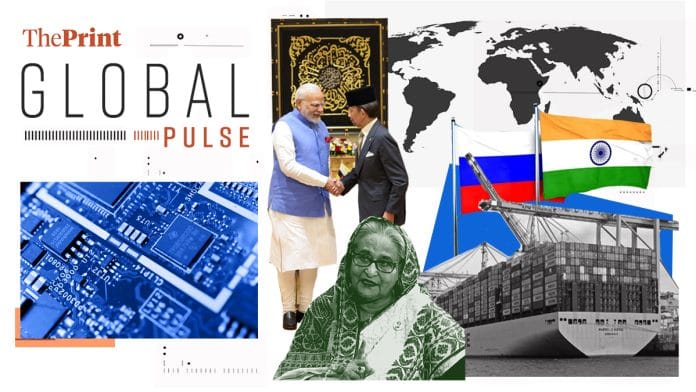New Delhi: India has been secretly supplying “sensitive” goods to Russia and offering building infrastructure to help Russia “secure components for its war effort”, the Financial Times reported Wednesday.
The “confidential” plans, according to leaked Russian state correspondence, seem to have been drawn up back in October 2022, giving the Russian industry and trade ministry—which oversees defence production—leeway to spend Rs 82 billion ($1 billion at the time) to procure “critical electronics through channels hidden from western governments”.
India has been seen by Russia as an alternative market for crucial goods that were “previously supplied from unfriendly countries”. The goodwill extends to the significant reserves of rupees currently sitting in Russian banks from oil sales to India. Buying “sensitive goods” from India is how the Russian government saw fit to use those rupees.
FT also reports that Russia and its Indian partners zoomed in on dual-use technologies, which have both civilian and military applications, and are subject to western export controls. The subsequent aim was to invest in Russo-Indian joint electronics development and production facilities, according to documents FT accessed.
The report comes just a few days after Prime Minister Narendra Modi’s triumphant tour of Ukraine, which was full of “warm hugs” and prayers. Global curiosity was piqued by the visit—did it signal a departure from traditionally warm relations with an increasingly frigid Russia? It was a good sign for champions of the West, as the Modi government has made concerted efforts to be drawn into the “US orbit”.
New Delhi’s relationship with Moscow has always been a thorn in America’s side, but the war in Ukraine increased friction in Washington. The US Deputy Treasury Secretary Wally Adeyemo had warned India’s banks in July not to do business with Russia’s military industrial base, saying that they would otherwise risk losing access to the U.S. financial system. It looks like India was doing just that.
“We know that the Russian military relies on importing sensitive goods, like machine tools and microelectronics, and it looks to foreign financial institutions to facilitate these transactions,” Adeyemo had written in the letter to the Indian Banks’ Association.
The big question now is whether India will receive a rap on its knuckles, and how hard.
Meanwhile, Modi is in Brunei for the first time. This is, in fact, the first time an Indian prime minister has visited the country on a bilateral trip ever. The visit coincides with the 40th anniversary of the establishment of diplomatic ties between the two countries. Modi met the Sultan, Hassanal Bolkiah, and vowed to expand trade ties, and both commercial and social linkages. Modi had met the Sultan of Brunei for the first time a decade ago on the sidelines of the 25th ASEAN Summit in Myanmar.
Next on Modi’s agenda is Singapore, where he is expected to attend a state dinner Wednesday night, hosted by Prime Minister Lawrence Wong. ANI reports that “incredible level of enthusiasm” has gripped the Indian diaspora in Singapore, replete with giddy bytes from people extolling India’s growth trajectory.
The Straits Times takes a slightly more sober stance. This will be the Singaporean prime minister’s first bilateral meeting with India since taking office in May. The visit is expected to be like a curtain-raiser for 2025, which will mark 60 years of diplomatic relations, as well as a decade of bilateral strategic partnership.
Singapore is the largest foreign direct investor in India, The Straits Times notes, and Modi will be attending a business roundtable with the Singapore Business Federation, with a special interaction planned with leaders in Singapore’s semiconductor ecosystem. This comes a day after the Union Cabinet approved India’s fifth semiconductor facility in Gujarat, a response to the panicked shortages of semiconductors during the pandemic.
Singapore’s Foreign Minister, Vivian Balakrishnan, had previously said that both countries are exploring mutual opportunities for growth. These comments were made on the sidelines of the India-Singapore Ministerial Roundtable, which took place on 26 August and laid the foundation for Modi’s visit.
“We have skin in the game as well, and we certainly have much to gain as the Indian economy develops and increases in sophistication and global prominence,” said Balakrishnan, who incidentally has Indian Tamil-Chinese heritage.
While both Russia and Singapore are eyeing India for potential trade promises, the optimism doesn’t seem to extend to Bangladesh.
The Guardian reports that India is in a bit of a Bangladeshi “bind”. The government’s close ties to Sheikh Hasina are like a noose around healthy diplomatic relations as Delhi continues to harbour the ousted prime minister. It looks like America had a role to play in the region, too.
“According to diplomatic sources, India used its close relationship with the US to ease pressure on Hasina before the election in early 2024,” reads the piece.
The Guardian notes that the US Ambassador to Bangladesh Peter Haas and the US Assistant Secretary of State for South Asia Donald Lu were initially focused on ensuring free and fair elections earlier this year.
“However, after intervention by India, the US secretary of state, Antony Blinken, reportedly told Haas and Lu to ‘knock it off with Bangladesh’, dealing a blow to opposition parties that had hoped for US support. Hasina was easily returned to power amid widespread allegations of rigging,” the report continues.
The anger against India and Indian support for Hasina is still palpable, as ThePrint had reported from Dhaka earlier, and so is the friction between Washington and New Delhi as both try to play their own game in the region.
Remember the call between Modi and President Joe Biden last week: the Indian side made a statement that the leaders had discussed Bangladesh and agreed on the need for “early restoration of normalcy”. But the US version of the call did not mention Bangladesh even once.
(Edited by Mannat Chugh)






